
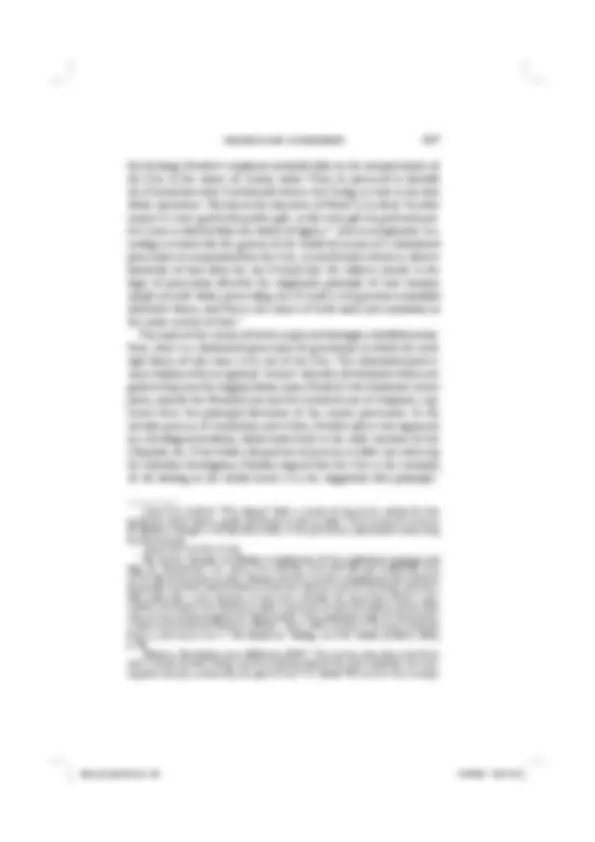
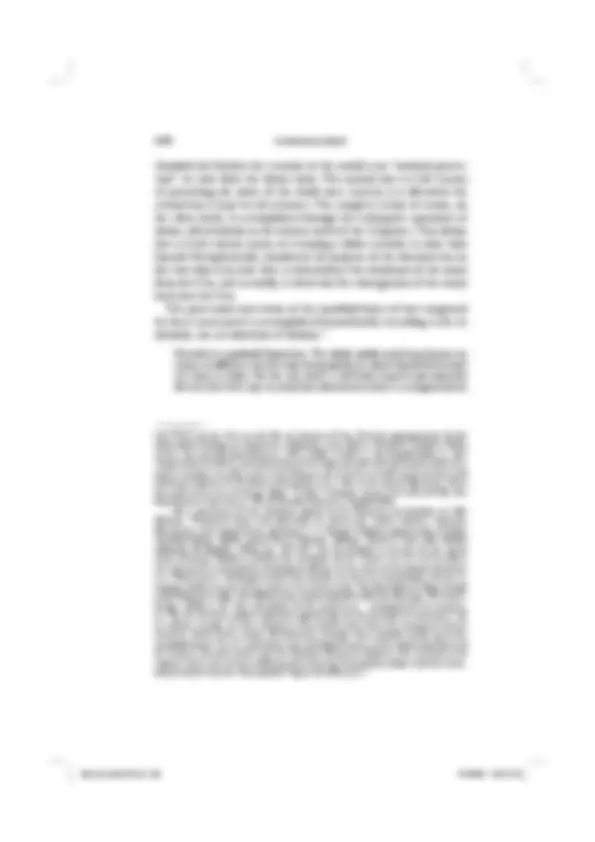
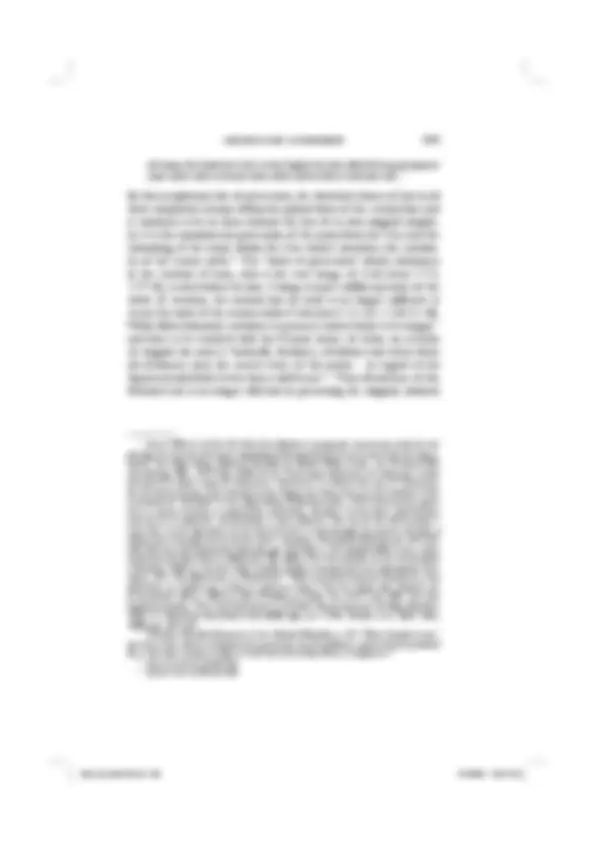
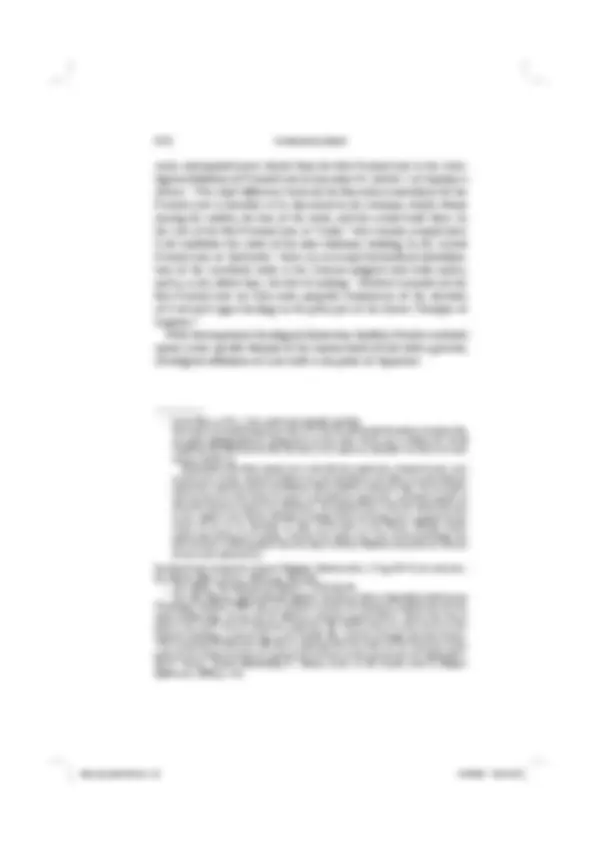
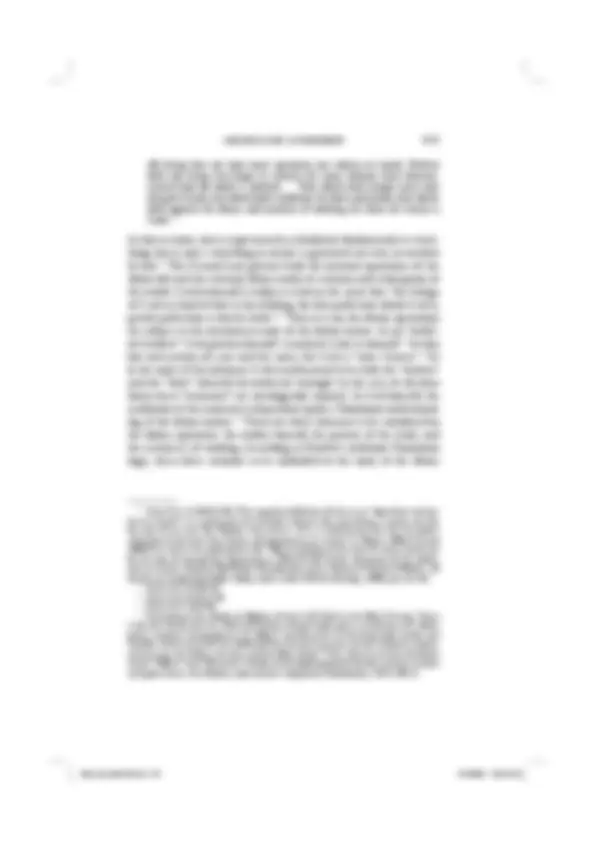
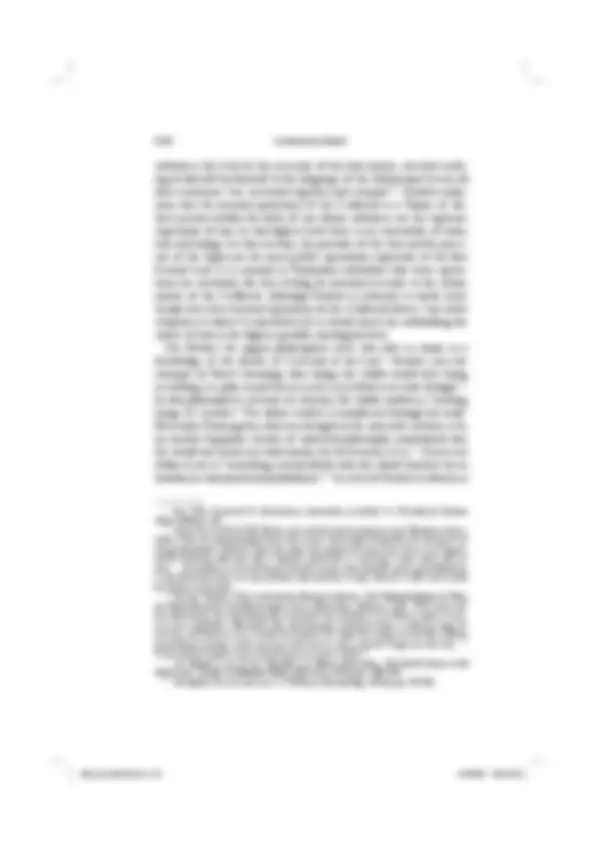
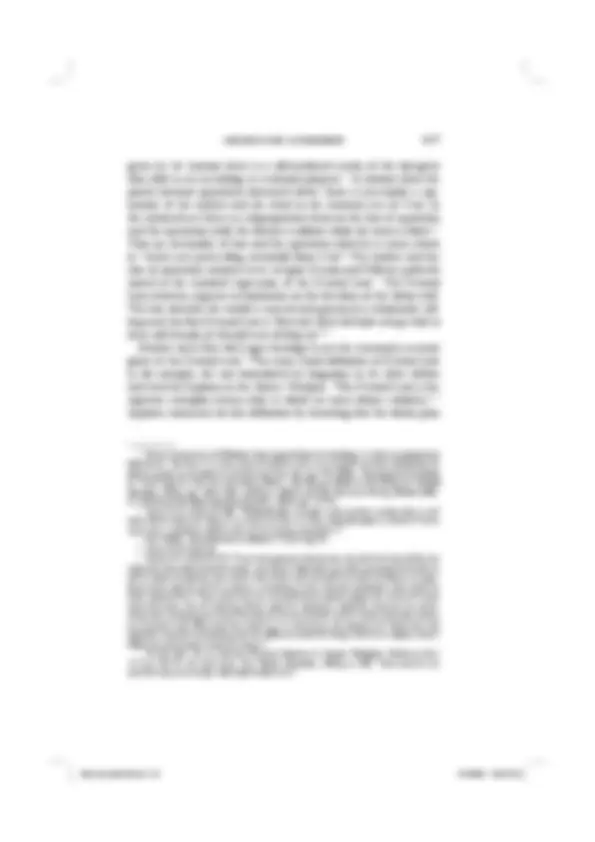
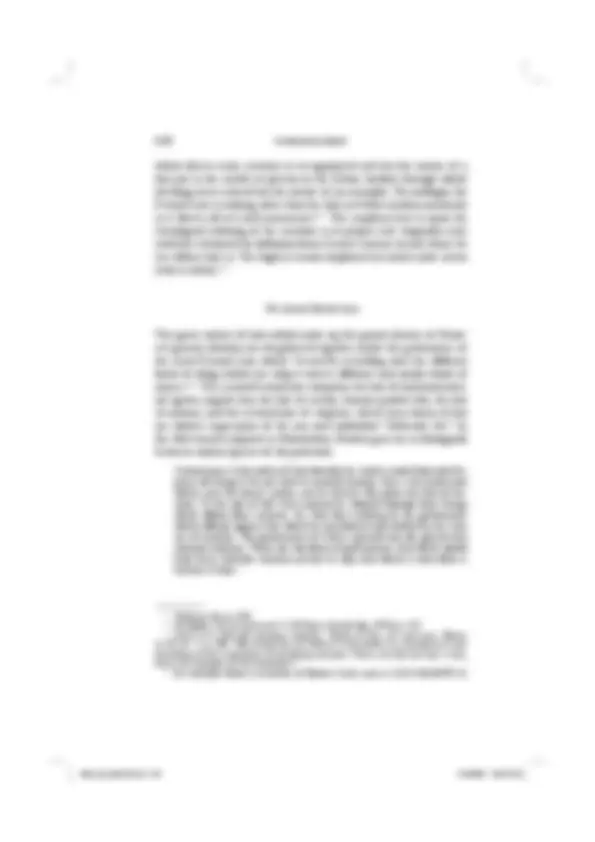
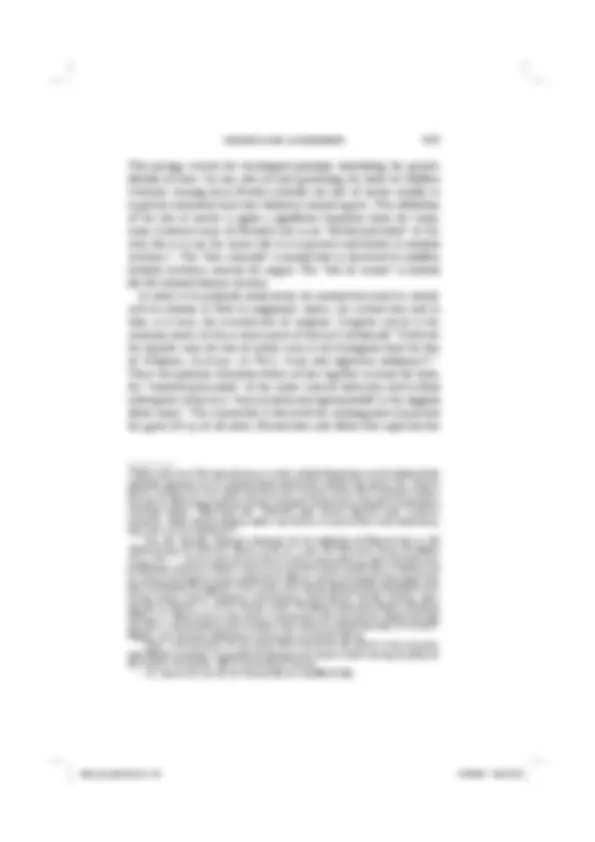
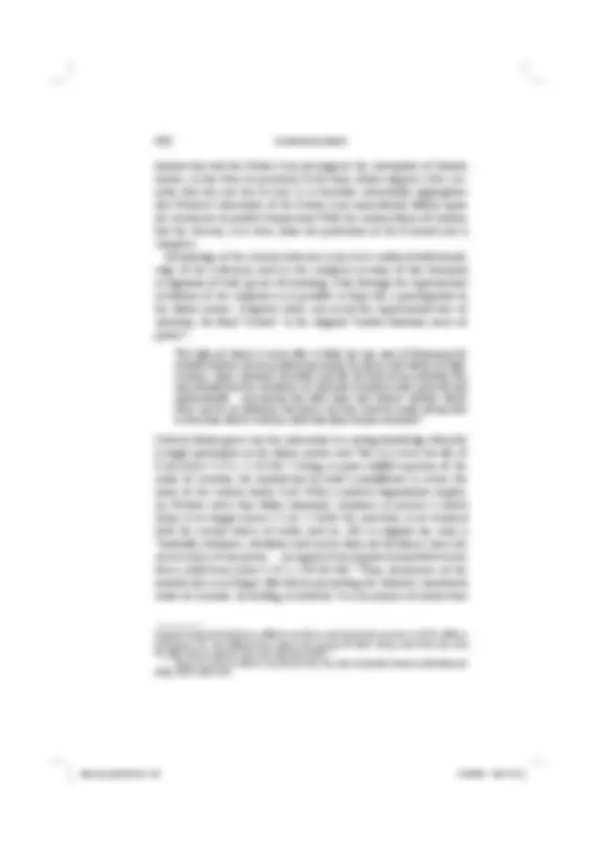
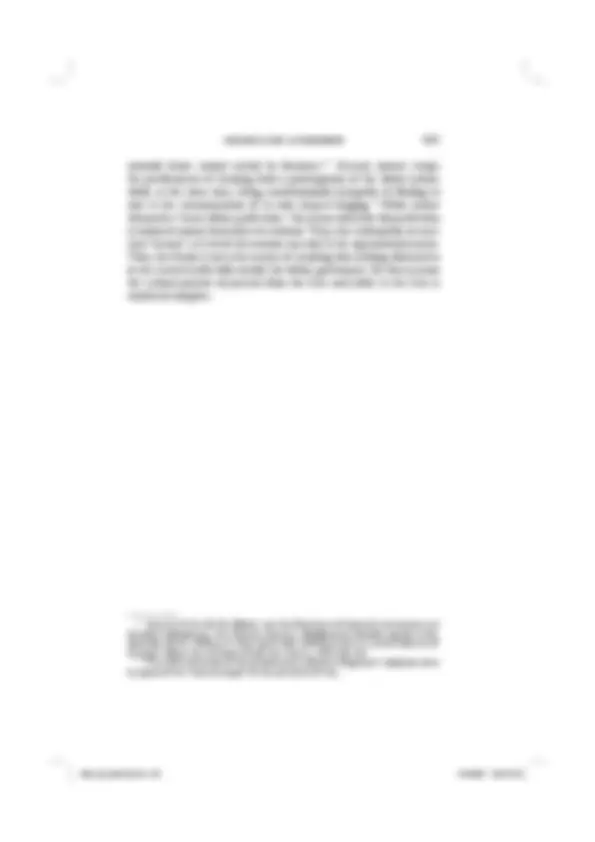


Study with the several resources on Docsity

Earn points by helping other students or get them with a premium plan


Prepare for your exams
Study with the several resources on Docsity

Earn points to download
Earn points by helping other students or get them with a premium plan
Community
Ask the community for help and clear up your study doubts
Discover the best universities in your country according to Docsity users
Free resources
Download our free guides on studying techniques, anxiety management strategies, and thesis advice from Docsity tutors
In his treatise 'Of the Lawes of Ecclesiasticall Politie,' Richard Hooker constructs a complex system of laws, rooted in the eternal law, which is the highest wellspring and fountaine of all other kinds of law. Hooker's neoplatonic vision of the procession of the dialectical division of the manifold forms of law out of the one eternal law. the unity of the system of laws, the role of the Creator as the lawgiver, and the various kinds of law, including natural law, divine law, and the law of scripture.
Typology: Summaries
1 / 19

This page cannot be seen from the preview
Don't miss anything!












Torrance Kirby
In the first book of his treatise Of the Lawes of Ecclesiasticall Politie , Richard Hooker constructs a complex generic division of the various forms of law. His approach to the definition of law is remarkable for its simulta- neous appropriation of a systematic neoplatonic structure of argument and its appeal to orthodox Protestant assumptions with respect to the relation of the orders of Nature and Grace.^1 At the outset of Book One Hooker offers a brief sketch of his argument in which he provides a useful starting-point for understanding the neo-platonic structure of his system of laws. He begins with an allusion to the polemical occasion of the treatise in the ecclesiological controversies which arose in England as a consequence of the Elizabethan Settlement of 1559:
Because the point about which wee strive is the qualitie of our Lawes , our first entrance hereinto cannot better be made, then with consider- ation of the nature of lawe in generall, and of that lawe which giveth life unto all the rest, which are commendable just and good, namely the lawe whereby the Eternall himselfe doth worke. Proceeding from hence to the lawe first of nature, then of scripture, we shall have the easier accesse unto those things which come after to be debated, concerning the particular cause and question which wee have in hand. 2
(^1) W. David Neelands argues that while Hooker recognizes Calvin’s threefold use of the law, the former’s organization of the system of laws owes little to Calvin, and thus Hooker’s “treatment of law was a clear departure from these Reformation themes, although it did not oppose them.” See Neelands’ essay, “Scripture, Reason and ‘Tradi- tion’,” in Richard Hooker and the Construction of Christian Community , ed. A.S. McGrade (Tucson, 1997) p. 77. For an important discussion of related questions see W.J. Hankey, “Augustinian Immediacy and Dionysian Mediation in John Colet, Edmund Spenser, Richard Hooker and the Cardinal de Bérulle,” in Augustinus in der Neuzeit, Colloque de la Herzog August Bibliothek de Wolfenbüttel, 14–17 octobre, 1996 , sous la direction de Kurt Flasch et Dominique de Courcelles, éd. Dominique de Courcelles, (Turnhout, 1998), pp. 125–160. I am much indebted to Dr. Hankey for his contribution to my thinking on this question. 2 Lawes I.1.3 (1:58.11–19).
406 torrance kirby
By this account, the idea of law is fundamentally threefold. First there is the law “which God hath eternallie purposed himself in all his works to observe.” 3 This eternal law is the “highest welspring and fountaine” of all other kinds of law. While there are a great variety of derivative forms of law, they are contained, as it were, within two principal kinds: the law of nature and the revealed law of scripture. The latter is often referred to by Hooker as the divine law, which is not to be confused with eternal law. These three summa genera —eternal law, natural law and divine law— together constitute a comprehensive division of the “kinds” of law. On account of the subordination the two derivative summa genera to the one eternal law, there is a sense in which Law, viewed from the standpoint of its divine originative principle, is simply one. This apparent ambiguity of the simultaneous unity and multiplicity of law lies at the very heart of Hooker’s neoplatonic vision of the procession of the dialectical division of the manifold forms of law out of the one eternal law.^4
The Neoplatonic Structure of Hooker’s Discourse
The starting-point (ἀρχή) of Hooker’s logic of generic division is clas- sically neoplatonic. The exposition begins properly with God himself that is God understood as “the One.” Hooker states most emphatically that “God is one, or rather verie Onenesse , and meere unitie, having noth- ing but it selfe in it selfe, and not consisting (as all things do besides God) of many things.” 5 In the neoplatonic cosmology, both pagan and Christian, the One is the highest principle and the supreme source of all that is, of all essences and existences, of intellect and of intelligibil- ity, and also of all order in the world. Given the political orientation of
(^3) Lawes I.3.1 (1:63.7). (^4) On the concept of the procession of the forms of law see, for example, I.3.4 (1:68.6– 8): “... the naturall generation and processe of all things receyveth order of proceeding from the setled stabilitie of divine understanding.” 5 Lawes I.2.2 (1:59.20–22). This emphasis upon God’s simplicity of being is central to neoplatonic thought. The ‘One’ of Plotinus transcends thought and all determi- nacy, and is the ἑναδ from which and to which all multiplicity proceeds. See Plotinus, The Enneads , trans. Stephen McKenna, (Burdett, 1992), III.8, pp. 273–287; V.4, pp. 460–464; VI.9, pp. 698–709. On the importance of the doctrine of the One in the thought of Plotinus, see Elmer O’Brien, ed., The Essential Plotinus: Representative Treatises from the Enneads , 2nd ed. (Indianapolis: Hackett, 1978), pp. 17–21. For a Christian appro- priation of this doctrine see also Pseudo-Dionysius, The Divine Names , in The Complete Works , trans. Colm Luibheid and Paul Rorem (Mahwah, NJ, 1987), chapter 13 concern- ing ‘Perfect’ and ‘One,’ 977B 1–981B 8, pp_._ 127–130.
408 torrance kirby
Similarly for Hooker the creation of the world is an “outward proces- sion” or exitus from the divine unity. The natural law is God’s means of preserving the order of the world once created; it is effectively the eternal law as kept by all creatures. The complete action of return, on the other hand, is accomplished through the redemptive operation of divine self-revelation in the written word of the Scriptures. This divine law is God’s chosen means of restoring a fallen creation to unity with himself. Metaphysically considered, the purpose of the discourse has in fact two objects in view: first, to demonstrate the derivation of the many from the One, and secondly, to show also the reintegration of the many back into the One. The procession and return of the manifold forms of law comprised by these summa genera is accomplished hierarchically according to the lex divinitatis , the so-called law of divinity:^10
For order is a graduall disposition. The whole world consisting of partes so manie so different is by this only thing upheld, he which framed them hath sett them in order. Yea the very deitie it self both keepeth and requireth for ever this to be kept as a law, that wheresoever there is a coagmentation
and VI.9.3 on the One as end. For an instance of the Christian appropriation of this exitus-reditus theology see Augustine, Confessions , trans. Henry Chadwick (Oxford, 1991), 13.4.5. See also Pseudo-Dionysius, CH 1 120B 1–120A 2, The Complete Works , p. 145: “Inspired by the father, each procession of the Light spreads itself generously toward us, and in its power to unify, it stirs us by lifting us up. It returns us back to the oneness and deifying simplicity of the Father who gathers us in. For, as the sacred Word says, ‘from him and to him are all things’ (Rom. 11:36).” Compare Lawes I.2.6 (1:62.14–20). See Paul Rorem’s note 4 on p. 145 of Pseudo-Dionysius, Complete Works. (^10) For a discussion of the scholastic appeal to the Dionysian lex divinitatis see W.J. Hankey, “‘Dionysius dixit,’ Lex divinitatis est ultima per media reducere: Aquinas, Hierocracy and ‘augustinisme politique’,” in Tommaso d’Aquino: proposte nuove di letture. Festschrift Antonio Tognolo , edited Ilario Tolomio, Medioevo. Rivista di Storia della Filosofia Medievale , 18 (Padova, 1992), pp. 119–150. The lex divinitatis is the law of the “great chain of being.” Hooker mentions the metaphor of the “chain” at I.11.1 (1:111.14) in the context of an Aristotelian teleological defense of the unity of all motion and desire in a “finall cause.” Although he does not actually use the term lex divinitatis , Arthur O. Lovejoy defines the law of the chain in his classic study The Great Chain of Being: A Study of the History of an Idea, The William James Lectures delivered at Harvard University, 1933 (Cam- bridge, 1936), p. 59: “the conception of the universe as... composed of an immense, or—by the strict but seldom rigorously applied logic of the principle of continuity—of an infinite, number of links ranging in hierarchical order from the meagerest kind of existents, which barely escape non-existence, through ‘every possible’ grade up to the ens perfectissimum —or, in a somewhat more orthodox version, to the highest possible kind of creature, between which and the Absolute Being the disparity was assumed to be infinite—every one of them differing from that that immediately above and that imme- diately below it by the ‘least possible’ degree of difference.”
creation and government 409
of many, the lowest be knitt to the highest by that which being interjacent may cause each to cleave unto other and so all to continue one.^11
By this neoplatonic law of procession, the derivative forms of law in all their complexity remain within the primal form of the eternal law, and it continues to be in them without the loss of its own original simplic- ity. It is the simultaneous procession of the many from the One and the remaining of the many within the One which constitutes the continu- ity of the cosmic order.^12 The “order of procession” which culminates in the creation of man, who is the very image of God ( Lawes I.7.2; 1:77.20), is also broken by him. Owing to man’s willful rejection of the order of creation, the natural law by itself is no longer sufficient to secure the unity of the cosmos under God ( Lawes I.11.5,6; 1:118.11–18). While fallen humanity continues to possess a natural desire to be happy,^13 and thus to be reunited with the Eternal source of order, on account of original sin man is “inwardly obstinate, rebellious and averse from all obedience unto the sacred Lawes of his nature... in regard of his depraved mind little better then a wild beast.”^14 Thus observance of the Natural Law is no longer effectual in preserving the original, divinely
(^11) Lawes VIII.2.1 (3:331.19–332.1) In Hooker’s autograph manuscript draft of this passage, he cites the Christian neoplatonist Pseudo-Dionysius as his source for this obser- vation. See Folger Library Edition of the Works of Richard Hooker , 6 vols., ed. W. Speed Hill (Cambridge, MA., 1977–93), 3:494.10–12: “Lex itaque divinitatis est infima per media ad suprema reduci, inquit B. Dionysius.” [And so it is a divine law, says St. Dionysius, for the lowest things to be led back to the highest by those that are intermediate.] The translation of “ divinitatis ” in the Folger Library Edition (hereafter, FLE ) Commentary, given here in square brackets, is potentially misleading. Divinitas is to be taken substantively and not as an adjective. Lex divinitatis is more properly “the law of the divine power” and refers to the operation of the Eternal Law in and through the process of exitus et reditus, that is through the law of the chain. Compare The Celestial Hierarchy , pp. 156–159, 166–169 and The Ecclesiastical Hierarchy , pp. 233–243 in The Complete Work s, trans. Colm Luibheid and Paul Rorem (Mahwah, NJ, 1987). This formulation of the lex divinitatis is Boniface VIII’s in the bull Unam Sanctam (1302), incorporated into Extravagantes Com- munes , 1.8.1 “De Maioritate et Obedientia”: “Nam secundum beatum Dionysium, Lex divinitatis est, Infima per media in suprema reduci.” See the Corpus Iuris Canonici , ed. P. Lancelotus (Paris, 1587), p. 853; Friedberg, 2:1245. See FLE 6 (2), 1081. See also David Luscombe, “The ‘Lex Divinitatis’ in the Bull ‘Unam Sanctam’ of Pope Boniface VIII,” in Church and Government in the Middle Ages , ed. C.N.L. Brooke et al. (New York, 1985), pp. 205–221. 12 Compare Pseudo-Dionysius in the Celestial Hierarchy , p. 157: “Even though in vari- ous ways every divine enlightenment proceeds, out of goodness, toward those provided for, it not only remains simple in itself but also unifies those it enlightens.” (^13) Lawes I.11.4 (1:114.8–10). (^14) Lawes I.10.1 (1:96.26–29).
creation and government 411
The Eternal Law: Creation and Government
If we will give judgement of the Lawes under which wee live, first let that law eternall be alwayes before our eyes, as being of principall force and moment to breede in religious mindes a dutifull estimation of all Lawes , the use and benefite whereof we see; because there can be no doubt but that Lawes apparently good, are (as it were) thinges copied out of the very tables of that high everlasting law, even as the booke of that law hath sayd concerning it selfe, By me Kinges raigne, and by me Princes decree justice.^21
The Eternal Law can be viewed from two principal standpoints, accord- ing to the distinction between the internal and the external operations of God. The internal operations are themselves distinguishable into natural and necessary operations of the divine life, on the one hand, and God’s voluntary works, on the other. The “necessary” internal operations have to do with the life of the Godhead as a Trinity of three persons in one eternal and divine substance. These workings are so inti- mately tied to the divine essence as to be above the power of the divine will. The “voluntary” internal operations, on the other hand, have to do with “that law eternall which God himself hath made to himselfe, and therby worketh all things wherof he is the cause and author.” In a sense this latter division of law looks towards the divine works which are ad extra , that is, which fall outside the simple divine life, even though these works are viewed as being contained within the will of their author. The Eternal Law as it governs the creation can also be viewed externally as the divine purpose “set downe as expedient to be kept by all his creatures according to the severall conditions wherwith he hath indued them.”^22 In the latter case, the operation of God ad extra is viewed from the stand- point of the creatures rather than the Creator. On the basis of these two standpoints Hooker distinguishes a first and a second Eternal Law. In the autograph manuscript of his Notes toward a Fragment on Predes- tination , Hooker observes that God’s external operation is twofold: cre- ation and government.^23 Government naturally presupposes creation. The second Eternal Law is all about the government of God and in this
(^21) Lawes I.16.2 (1:136.4–11). (^22) Lawes I.3.1 (1:63.9). (^23) Richard Hooker, Notes toward a Fragment on Predestination , Trinity College, Dublin, MS 364, fol. 80v, FLE 4: 86.11–17, also printed in Supplement II, FLE 3: 527.12–18: “Operatio Dei ad extra est duplex: Creatio. Gubernatio. Gubernatio praesupponit cre- ationem. Non enim gubernatur quod non est.”
412 torrance kirby
sense corresponds more closely than the first Eternal Law to the teleo- logical definition of Eternal Law in Question 93, Article 1 of Aquinas’s Summa.^24 The chief difference between the first and second forms of the Eternal Law is therefore to be discerned in the relations, which obtain among the worker, the law of the work, and the actual work done. In the case of the first Eternal Law, or “ creatio ,” they remain coequal since God establishes the order of his own voluntary working. In the second Eternal Law, or “ gubernatio ,” there is a necessary hierarchical subordina- tion of the creaturely work to the Creator lawgiver who both makes, and is, as the divine logos , the law of making.^25 Hooker’s remarks on the first Eternal Law are thus more properly reminiscent of the doctrine of God and Logos theology in the prima pars of th e Summa Theologiae of Aquinas. 26 With this important theological distinction clarified, Hooker embarks upon a more specific division of the various kinds of law with a general, teleological definition of Law itself as his point of departure:
(^24) In Ia–IIae, q. 93 a. 1 the contra and respondeo read thus: Sed contra est quod Augustinus dicit (in I De Lib. Arb. ) quod lex aeterna est summa ratio, cui semper obtemperandum est. [Augustine, on the other hand, says in Book I of On the Freedom of the Will that the Eternal Law is the supreme exemplar to which we must always conform.] Respondeo dicendum quod, sicut ratio divinae sapientiae, inquantum per eam cuncta sunt creata, rationem habet artis, vel exemplaris, vel ideae, ita ratio divinae sapientiae moventis omnia ad debitum finem obtinet rationem legis. Et secundum hoc lex aeterna nihil aliud est quam ratio divinae sapientiae, secundum quod est directiva omnium actuum et motionum. [I respond that it must be stated that just as the model in the Divine Wisdom through which all things were created has the nature of an art or exemplar or idea, so the plan in the Divine Wisdom which moves everything to its proper end has the nature of a law. And accordingly the Eternal Law is nothing other than the idea in Divine Wisdom inasmuch as it directs all acts and movements.] So edited and translated in Summa Theologiae: Treatise on Law: 1–2 qq 90–97 , ed. and trans. R.J. Henle (Notre Dame, 1993), pp. 204–205. 25 See Gibbs, “Introduction to Book I,” FLE 6 (I), 99. (^26) See W.J. Hankey, God In Himself: Aquinas’s Doctrine of God as Expounded in the Summa Theologiae (Oxford, 1987). For an excellent account of Aquinas’s employment of the exitus et reditus logic, see pp. 22–35. Hankey maintains against M.-D. Chenu that Christ alone is the via of return in Aquinas’ argument. For Chenu, there are two returns in the Thomist theology, a natural one in the Secunda Pars , and one through gracious history: “The transition of IIa to the IIIa Pars is a passage from the order of the necessary to the order of the historical, from an account of structures to the actual story of God’s gifts”: M.-D. Chenu, Toward Understanding St. Thomas , transl. A.-M. Landry and D. Hughes (Montreal, 1964), p. 315.
414 torrance kirby
substance, for God, by the necessity of his own nature, can have noth- ing in himself but himself. In the language of the Athanasian Creed, all three moments “are coeternal together and coequal.”^32 Hooker main- tains that the internal operations of the Godhead as a Trinity of dis- tinct persons within the unity of one divine substance are the supreme expression of law. At this highest level there is no externality of ruler, rule and ruling. On this account, the generation of the Son and the proces- sion of the Spirit are the most perfect operations expressive of the first Eternal Law. It is essential to Trinitarian orthodoxy that these opera- tions are involuntary for they belong by internal necessity to the triune nature of the Godhead. Although Hooker is reluctant to wade more deeply into these internal operations of the Godhead (where “our safest eloquence is silence”) nonetheless he is clearly intent on establishing the source of law at the highest possible ontological level. For Hooker the pagan philosophers were also able to attain to a knowledge of the nature of God and of his Law.^33 Hooker cites the example of Plato’s demiurge who brings the visible world into being according to a plan or pattern (παραδειγμα) which is its own thought. 34 In this philosopher’s account of creation, the visible world is a “moving image of eternity.” The divine worker is manifested through his work. Mercurius Trismegistus, who was thought in the sixteenth century to be an ancient Egyptian teacher of universal philosophy, maintained that the world was made not with hands, but by Reason (νοῦς).^35 Cicero too defines Law as “something eternal which rules the whole universe by its wisdom in command and prohibition.” 36 In each of Hooker’s references
(^32) See “The Creed of St. Athanasius, commonly so called,” in The Book of Common Prayer (1662), v. 26. (^33) Lawes I.2.3 (1:59.33–60.14) the wise and learned among the verie Heathens them- selves, have all acknowledged some first cause, whereupon originallie the being of all things dependeth. Neither have they otherwise spoken of that cause, then as an Agent, which knowing what and why it worketh, observeth in working a most exact order or lawe.... all confesse in the working of that first cause, that counsell is used, reason followed, a way observed, that is to say, constant order and law is kept, wherof it selfe must needs be author unto itselfe. 34 See the Timaeus , 37d, translated by Benjamin Jowett, The Collected Dialogues of Plato , ed. Edith Hamilton and Huntington Cairns (Princeton, 1961), p. 1167: “The nature of the ideal being was everlasting, but to bestow this attribute in its fullness upon a crea- ture was impossible. Wherefore [the demiourgos] resolved to have a moving image of eternity, and when he set in order the heaven, he made this image eternal but moving according to number, while eternity itself rests in unity, and this image we call time.... Time and the heaven came into being at the same instant.” (^35) On Hooker’s use of the Hermetica see Wayne Shumaker, The Occult Sciences in the Renaissance: A Study in Intellectual Patterns (Berkeley, 1972), pp. 238–239. (^36) De Legibus 2.6, ed. and trans. C.W. Keyes (Cambridge, 1975), pp. 379–81.
creation and government 415
to pagan authors the same principle is revealed: order or law is a divine, and therefore self-mediating rational principle. “Neither have they oth- erwise spoken of their cause, then as an Agent, which knowing what and why it worketh, observeth in working a most exact order or lawe .” Thus, at the very highest level of both pagan and Christian theology, law is man- ifest as an eternal, self-originating, and self-mediating principle in which there is a distinction of the agent, the principle or rule of action, and the action or operation itself. Quite remarkably, Hooker seems to sug- gest in this passage that a Logos theology can be discerned in the pagan understanding of Law as the divine first principle and perhaps also, by implication, an adumbration of the Christian doctrine of the Trinity. Homer, Plato, the Stoics, and no less an authority than Thrice-great Hermes are all enlisted in support of the proposition implicit in these expressions of Logos theology, namely that God is Law.^37 From the stand- point of the natural knowledge of God, the conclusion reached is much the same: the life of God is the very substance of Law. Hooker identifies the light of reason with the divine Logos of the Prologue to John’s Gos- pel. Here the “word” of God in scripture is twinned with the “word” of rational human discourse in and through their common source, the eternal divine “Word.”^38 God the “light of light” is the author of both the light of reason and the revealed light of the scriptures ( Lawes III.8.9; 1:226.11–14).^39 God, the author of nature, speaks through nature whose voice is His instrument. 40
(^37) Lawes I.2.3 (1:60.4–11): “Thus much is signified by that which Homer mentioneth, ∆ιὸς δ’ ἐτελείετο βουλή ( Jupiter’s Counsell was accomplished ). Thus much acknowledged by Mercurius Trismegistus , Τὸν παύτα κόσμον ἐποίησεν ὁ δημιουργὸς οὐ χερσὶν ἀλλα λόγω ( The creator made the whole world not with hands, but by Reason). Thus much confest by Anax- agoras and Plato , terming the maker of the world an Intellectual worker. Finallie the Stoikes, although imagining the first cause of all things to be fire, held neverthelesse that the same fire having arte, did οδῷ βαδίζειν ἐπὶ γενεσει κόσμον ( Proceed by a certaine and a set Waie in the making of the world ).” (The translations here are Hooker’s own.) In the FLE Commentary on Book I, it is observed that Hooker derives his refer- ences to Anaxagoras, Plato and the Stoics from the fifth-century Stobaeus’s Eclogues. See P.G. Stanwood, “Stobaeus and Classical Borrowing in the Renaissance,” Neophilologus 59 (1975), 141–146. 38 Lawes III.9.3 (1:238.25): “The light of naturall understanding wit and reason is from God, he it is which thereby doth illuminate every man entering into the world. If there proceede from us any thing afterwardes corrrupt and naught, the mother thereof is our owne darknes, neither doth it proceede from any such cause whereof God is the author. He is the author of all that we thinke or doe by vertue of that light, which him- selfe hath given ( John 1:5).” 39 See Lawes V.56.2 (2:235.25–27): “The Sonne [is] in the father as light in that light out of which it floweth without separation; the father [is] in the Sonne as light in that light which it causeth and leaveth not.” (^40) Lawes I.8.3 (1:84.4) and see also I.3.4 (1:67.16–20, 68.18): “Those things which
creation and government 417
great act of creation there is a self-mediated action of the law-giver who wills to act according to a rational purpose.^45 As distinct from the purely internal operations discussed above, there is necessarily a sep- aration of the worker and the work in the outward acts of God. In the outward acts there is a disproportion between the law of operation and the operation itself; the former is infinite while the latter is finite.^46 Thus an externality of law and the operation ruled by it comes about in “everie acte proceeding externally from God.” The worker and the rule of operation continue to be coequal. Reason and Will are perfectly united in the outward expression of the Eternal Law.^47 The Eternal Law, however, imposes no limitation on the freedom of the divine will. The law whereby the world is created and governed is voluntarily self- imposed; the first Eternal Law is “ that order which God before all ages hath set down with himselfe, for himselfe to do all things by. ” 48 Hooker states that this Logos theology is not the customary account given of the Eternal Law.^49 The more usual definition of Eternal Law is, for example, the one formulated by Augustine in De Libero Arbitrio and cited by Aquinas in the Summa Theologiae : “The Eternal Law is the supreme exemplar ( summa ratio ) to which we must always conform.” 50 Aquinas comments on this definition by observing that the divine plan
(^45) Some interpreters of Hooker have argued that his theology is realist as opposed to voluntarist. Yet here it is clear that the divine will is an integral element alongside the divine reason in the doctrine of Eternal Law. See Lee W. Gibbs, “Introduction to Book I,” FLE 6 (I), 97, 103. See also Peter Munz, The Place of Hooker in the History of Thought (London, 1952; repr. New York, 1970), p. 140 ff. and W.J. Torrance Kirby, Richard Hook- er’s Doctrine of the Royal Supremacy (Leiden, 1997), pp. 13–15. (^46) Lawes I.2.5 (1:61.15–18): “Undoubtedly a proper and certaine reason there is of every finite worke of God, in as much as there is a law imposed upon it; which if there were not, it sould be in 47 finite even as the worker himselfe is.” See Gibbs, “Introduction to Book I,” FLE 6 (I), 97. (^48) Lawes I.2.6 (1:63.2). (^49) Lawes I.3.1 (1:63.6–17): “I am not ignorant that by law eternall the learned for the most part do understand the order, not which God hath eternallie purposed himselfe in all his works to observe, but rather that which with himselfe he hath set downe as expe- dient to be kept by all his creatures, according to the severall conditions wherewith he hath indued them. They who thus are accustomed to speake apply the name of Lawe unto that only rule of working which superior authority imposeth, whereas we some- what more enlarging the sense thereof, terme any kind of rule or canon whereby actions are framed a law. Now that law which as it is laid up in the bosome of God, they call aeternall , receyveth according unto the different kinds of things which are subject unto it differenct and sundry kinds of names.” 50 De Lib. Arb. , 1.6, as cited by Thomas Aquinas in Summa Theologiae: Treatise on Law: 1–2 q.q 90–97 , ed. and trans. R.J. Henle (London, 1993), p. 204: “Lex aeterna est summa ratio, cui semper obtemperandum est.”
418 torrance kirby
which directs every creature to its appointed end has the nature of a law just as the model or pattern in the Divine wisdom through which all things were created has the nature of an exemplar. “Accordingly, the Eternal Law is nothing other than the idea in Divine wisdom inasmuch as it directs all acts and movements.”^51 The emphasis here is upon the teleological ordering of the creation to its proper end. Augustine may well have obtained his definition from Cicero’s treatise on law where he too defines law as “the highest reason implanted in nature ( ratio summa insita in natura ).” 52
The Second Eternal Law
The great variety of laws which make up the grand scheme of Hook- er’s generic division are all gathered together under the governance of the second Eternal Law, which “receyveth according unto the different kinds of things which are subject unto it different and sundry kinds of names.” 53 The second Eternal law comprises the law of irrational natu- ral agents, angelic law, the law of reason, human positive law, the law of nations, and the revealed law of scripture. All of these forms of law are distinct expressions of the one and undivided “ Gubernatio Dei .” In the Notes toward a fragment on Predestination , Hooker goes on to distinguish between various species of this gubernatio :
Government is that work of God whereby he sustains created things and dis- poses all things to the end which he naturally chooses, that is the greatest good which, given the law of creation , can be elicited. For, given the law of cre- ation
(^51) Treatise on Law , p. 205. (^52) De Legibus , 1.4, ed. and transl. C.W. Keyes (Cambridge, 1975), p. 317. (^53) Lawes I.3.1 (1:63.16) Compare Aquinas, Treatise on Law , ed. and trans. Henle, Q. 93, art. 1, p. 200: “But things that are diverse in themselves are considered as one according to their ordination to something common. There, the Eternal Law is one, that is the exemplar of this ordination.” (^54) So reads John Booty’s translation of Hooker’s Latin notes in FLE 4: 86.28–87.12:
420 torrance kirby
Hooker the two motions of cosmic procession and return and in this way the two summa genera constitute a comprehensive division of the idea of law.^58 The natural law is God’s means of preserving the order of the world once created; it is effectively the eternal law as kept by all crea- tures. Had Adam continued in his unfallen state, the natural law would have sufficed to bring him to “the reward of blisse.” In the divine law of scripture God reveals his chosen means of restoring fallen creation to unity with himself. 59 This revealed way of redemption is also an expres- sion of the one eternal law; Hooker describes it as it is prepared by God in himself before all worlds ( Lawes I.11.6; 1:118.23). We shall seek to demonstrate that Hooker’s conservative neoplatonic presentation of this twofold division of the eternal law manifests in content the essentially Lutheran structure of the two realms of Creation and Redemption.^60 By the unaided illumination of natural reason, it is possible to distin- guish true from false, good from evil, and consequently, a certain degree of knowledge of the divine will itself is attainable without the help of supernatural revelation. This natural knowledge of God subsequently leads to a natural practical wisdom. To know theologically what human nature is and where it stands in the larger order of creation is the start- ing point for reflection upon the principles of human action ( Lawes I.8.6; 1:86.25–29). In this context, Hooker is able to compare the virtue of voluntary obedience to the natural law on the part of rational creatures with the external beauty of the hierarchically ordered cosmos ( Lawes I.8.9; 1:89.31–90.11). Building upon this argument with respect to the natural knowledge of God, he proceeds to show that one and the same
(^58) For further examples of Hooker’s employment of the neoplatonic language and logic of “procession,” see Lawes I.3.2 (1:65.4), I.3.4 (1:67.29) and (1:68.6–8), I.5. (1:73.5–8). At the latter he states: “Againe sith there can bee no goodnesse desired which proceedeth not from God himselfe, as from the supreme cause of all things; and every effect doth after a sort conteine, at least wise resemble the cause from which it pro- ceedeth: all things in the worlde are saide in some sort to seeke the highest, and to covet more or lesse the participation of God himselfe.” The neoplatonic logic of “procession” is aptly summarised by Proclus as follows: “every effect remains in its cause, proceeds from it, and returns to it.” The Elements of Theology , ed. E.R. Dodds (Oxford, 1963), p. 38. 59 Lawes I.11.5,6 (1:115.25–119.23). (^60) On the significance for Christian ethics of Luther’s distinction between the realms of Creation and Redemption, see William H. Lazareth, “Luther’s ‘Two Kingdom’ Ethic Reconsidered,” Christian Social Ethics in a Changing World , ed. John C. Bennett (New York, 1966); reprinted in Marburg Revisited: A reexamination of Lutheran and Reformed Tradi- tions , eds. Paul C. Empie and James I. McCord (Minneapolis, 1966), pp. 165–176. The latter edition is cited here.
creation and government 421
moral law is taught by Plato, Aristotle, Moses, and Christ with respect to our natural duty both towards God and our fellow man ( Lawes I.8.7,8; 1:87.9–89.2). The second great commandment in Christ’s summary of the law, for example, is grounded in the law of non-contradiction, a law of the rational faculty. Throughout this discussion of the axioms of virtuous action Hooker presupposes that “the mindes even of naturall men, have atteyned to know, not onely that there is a God, but also what power, force, wisedom, and other properties God hath, and how all things depende on him.”^61 Given that rational, free creation has lost its “way” due to the Fall, it is necessary to the preservation of the created order that there be a special revelation from God in the Divine Law of the Scriptures, both through the Law and the Prophets and through the Gospel of Christ. Finally, there is need of positive “humane law” or “such Lawes of government as serve to direct even nature depraved to a right end.”^62 The latter is fur- ther divided into categories of civil, ecclesiastical, and international law, of which the latter contains within it the laws of arms and embassage. Special law, for example, which governs the authority of general coun- cils of the church, can be regarded as a hybrid species of ecclesiastical law and the law of nations.^63 The subdivision can certainly go a great deal further. The chief point to observe is that the structure of the divi- sion is theologically determined by three main distinctions. First, there is the twofold character of God’s external operation as “Maker and Preserver of all things both visible and invisible.”^64 God’s work as Cre- ator is distinct from his work as Governor; hence the distinction of the first and second Eternal Laws. Secondly, there is a distinction between God’s general government over all creatures and a special government over rational creatures. Out of the latter arises the distinction between the main species of Natural Law. Finally, the mode of the special divine government over rational creatures is itself twofold on account of the Fall. The Natural Law is both a law of reason and the pattern for posi- tive human law. Human law serves as a remedy for sin. 65 Both positive
(^61) Lawes I.8.7 (1.87.14–17). See W. David Neelands, “Scripture, Reason and ‘Tradi- tion’,” in Richard Hooker and the Construction of Christian Community , ed. A.S. McGrade (Tucson, 1997) pp. 76–77. (^62) Lawes I.10.1 (1:96.33). (^63) See Lawes I.10.14 (1:109.2–110.16) where Hooker refers to the “ Lawes of spirituall commerce betweene Christian nations.” 64 Article I (Of Faith in the Holy Trinity) in the Articles of Religion. (^65) Lawes I.10.13 (1:108.3–7): “... those Lawes of reason which (man retayning his
creation and government 423
naturall desire cannot utterly be frustrate.”^67 Reason cannot escape the predicament of desiring both a participation of the divine nature while, at the same time, being constitutionally incapable of finding its way to the consummation of its own deepest longing.^68 While nature demands a “more divine perfection,” the means whereby this perfection is attained cannot themselves be natural. Thus, the redemption or mys- tical “return” to God of all creation can only be by supernatural means. Thus, the Divine Law is the means of ensuring that nothing whatsoever in the created order falls outside the divine governance. By this account the cyclical pattern of processio from the One and reditus to the One is rendered complete.
(^67) Lawes I.11.4 (1:114.15). Hooker cites the Proemium of Aquinas’s commentary on Aristotle’s Metaphysics. See Thomas Aquinas, Metaphysicorum Aristotelis expositio in duo- decim libros (Turin, 1950), p. 6. That nature does nothing in vain is a central doctrine of Aristotle’s 68 Physics. See De Caelo 271a34. See Comm., FLE 6 (I), 513. The classic discussion of this predicament is found in Augustine’s Confessions when he speaks of the “natural weight” of the soul (13.9.10–11).